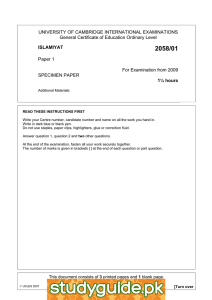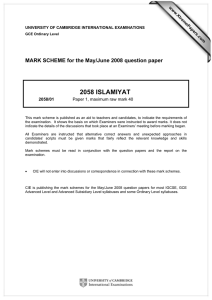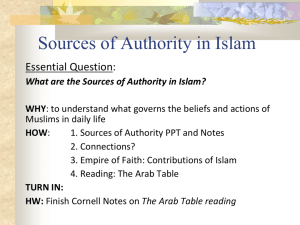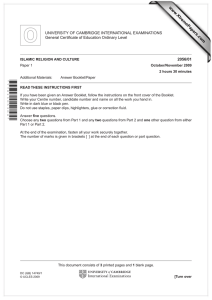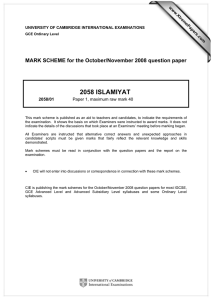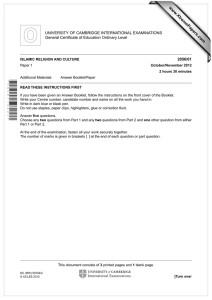2058 ISLAMIYAT MARK SCHEME for the October/November 2010 question paper
advertisement
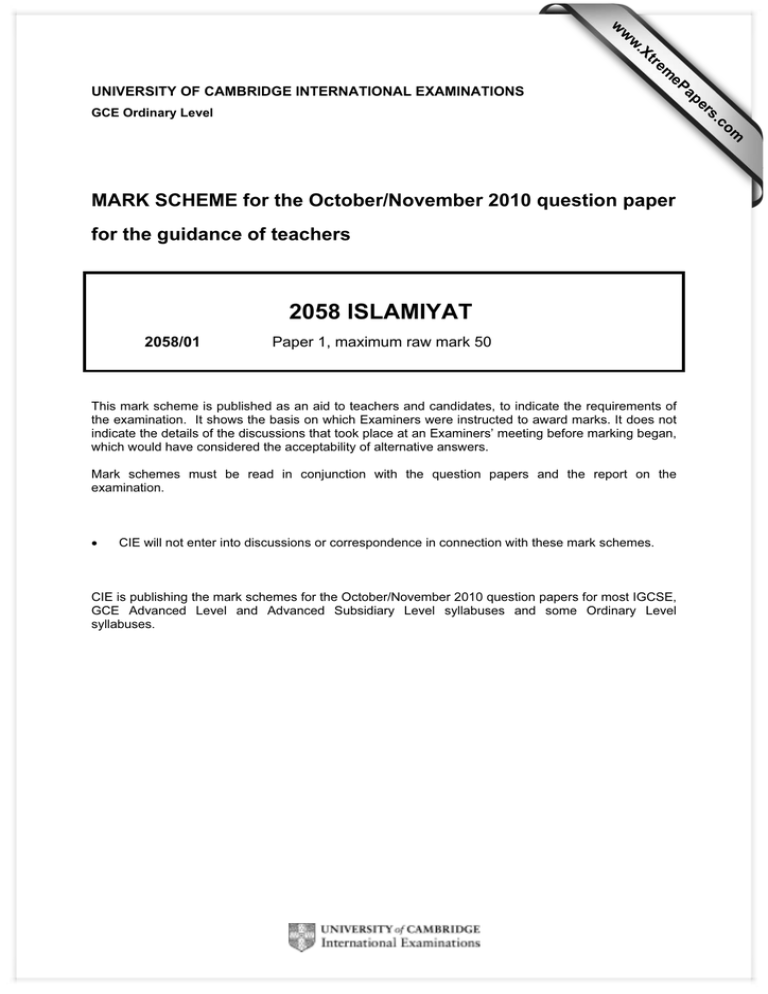
w w ap eP m e tr .X w UNIVERSITY OF CAMBRIDGE INTERNATIONAL EXAMINATIONS s er om .c GCE Ordinary Level MARK SCHEME for the October/November 2010 question paper for the guidance of teachers 2058 ISLAMIYAT 2058/01 Paper 1, maximum raw mark 50 This mark scheme is published as an aid to teachers and candidates, to indicate the requirements of the examination. It shows the basis on which Examiners were instructed to award marks. It does not indicate the details of the discussions that took place at an Examiners’ meeting before marking began, which would have considered the acceptability of alternative answers. Mark schemes must be read in conjunction with the question papers and the report on the examination. • CIE will not enter into discussions or correspondence in connection with these mark schemes. CIE is publishing the mark schemes for the October/November 2010 question papers for most IGCSE, GCE Advanced Level and Advanced Subsidiary Level syllabuses and some Ordinary Level syllabuses. Page 2 Mark Scheme: Teachers’ version GCE O LEVEL – October/November 2010 Syllabus 2058 Paper 01 AO1 (Knowledge – part (a) questions) Question 1(a) has a maximum mark of 4 and questions 2–5 have a maximum mark of 10. Level 4 3 2 Mark Question 1 4 3 2 Mark Question 2 Level Descriptor 8–10 Very Good/Excellent. A thorough, well-developed and substantial response. Demonstrates extensive, relevant and highly accurate knowledge of the subject in considerable detail and with evident expertise. Likely to quote Qur’an verses and Hadiths to support and illustrate points made. Comprehensive and thoughtful. 5–7 Good. Addresses the question confidently and coherently. Demonstrates sound, detailed and generally relevant and accurate knowledge of the subject matter in great detail. Covers the main points. May quote Qur’an verses and Hadiths to support points made. 3–4 Satisfactory. A fair, mainly relevant but generally undeveloped response. The candidate demonstrates some factual knowledge, which is fairly accurate and slightly wider than at basic level. Some of the main points are covered but lack substance. 1 1 1–2 Basic. An attempt to answer the question, but lacks potential and/or is unfinished. Very limited knowledge of the subject. Response includes only a small amount of relevant material, or mainly irrelevant points. Facts are reported in basic outline only, often inaccurately, though some credible points are made. 0 0 0 Irrelevant. No apparent attempt to answer the question set, or a wholly irrelevant response. Totally illegible. AO2 (Understanding – part (b) questions) Level Mark Level Descriptor 4 4 Very Good/Excellent. Demonstrates a wide and thorough understanding of what the question asks. Recognises fully and can explain the significance of material used in answer. Can reason, evaluate and discuss in a thoughtful, mature manner. 3 3 Good. Understands the significance of the question. Seeks to move clearly beyond a purely descriptive approach, demonstrating touches of maturity and a willingness to engage with and discuss the material. 2 2 Satisfactory. Response is descriptive but makes some effort to offer evaluation. The candidate attempts, though with limited success, to move beyond a purely factual approach, with some limited discussion of the material. 1 1 Basic. Limited understanding of the subject. The candidate’s response is descriptive and immature, with no attempt to discuss or evaluate the material. 0 0 Irrelevant. No response submitted, or clearly lacks any understanding of the subject matter. © UCLES 2010 Page 3 Mark Scheme: Teachers’ version GCE O LEVEL – October/November 2010 Syllabus 2058 Paper 01 Candidates must attempt Question 1, Question 2 and two other Questions. 1 Choose any two of the following passages from the Qur’an, and (a) briefly describe the main theme(s) in each passage; [4] (b) briefly explain how each passage presents its theme(s) in a distinctive way. [4] In order to give a mark for AO1 you will have to read both part (a) answers, and similarly in order to give a mark for AO2 you will have to read both part (b) answers. You should give only two marks, one for both part (a) answers, and one for both part (b) answers. When marking this question, you may have to read the answers a number of times. (1) Sura 5.110 Then will Allah say: ‘Jesus son of Mary! Recount my favour to you and to your mother. Behold! I strengthened you with the holy spirit, so that you spoke to the people in childhood and maturity. Behold! I taught you the Book and Wisdom, the Law and the Gospel. And behold! You make out of clay, as it were, the figure of a bird, by my leave, and you breathe into it and it becomes a bird by my leave, and you heal those born blind, and the lepers, by my leave. And behold! You bring forth the dead by my leave. And behold! I restrained the Children of Israel from you when you showed them the clear signs, and the unbelievers among them said: ‘This is nothing but evident magic.’’ (2) Sura 6.75-79 75. So also did We show Abraham the power and the laws of the heavens and the earth, so that he might have certainty. 76. When the night covered him over, he saw a star: He said: ‘This is my Lord.’ But when it set, he said: ‘I do not love things that set.’ 77. When he saw the moon rising in splendour, he said: ‘This is my Lord.’ But when the moon set, he said: ‘Unless my Lord guides me, I will surely be among those who go astray.’ 78. When he saw the sun rising in splendour, he said: ‘This is my Lord; this is the greatest.’ But when the sun set, he said: ‘O my people! I am indeed free from your giving partners to Allah.’ 79. ‘For me, I have set my face firmly and truly towards Him who created the heavens and the earth, and never shall I give partners to Allah.’ (3) Sura 93 1. By the glorious morning light, 2. And by the night when it is still, 3. Your Lord has not forsaken you, nor is He displeased. 4. And truly the Hereafter will be better for you than the present. 5. And soon your Lord will give you so that you will be pleased. 6. Did He not find you an orphan and give you shelter? 7. And He found you wandering, and He gave you guidance. 8. And He found you in need, and made you independent. 9. Therefore, do not treat the orphan with harshness, 10. Nor drive the beggar away; 11. But tell about the bounty of your Lord! © UCLES 2010 Page 4 Mark Scheme: Teachers’ version GCE O LEVEL – October/November 2010 Syllabus 2058 Paper 01 (a) What are the main teachings? (1) Sura 5.110 This passage talks about God’s relationship with his messengers, in this case the prophet Jesus. Candidates could talk about God’s power and authority over all things, that it is He who allows all things to happen. He gives his prophets miracles and powers as a reflection of His power, but also to help them. Just as He helps them in their guidance for people, He also protects them from harm. (2) Sura 6.75-79 This passage is about God showing His signs to mankind to strengthen their belief and so they know about His Oneness, as well as helping his prophets when they are in need. Candidates could mention that the signs of the sun and the moon and the star were shown to Abraham to clear his confusion about his ancestor’s belief in idols. These verses tell Muslims to worship god alone. (3) Sura 93 This sura was revealed as a consolation to the Prophet Muhammad that God has not left Him, as the disbelievers claimed. Rather God shows in this sura how he helped the Prophet, as He helps all his prophets. Candidates could mention that these verses give reassurance that God is always there to help in need. The Prophet has been told to help those in need and be grateful to God, and mankind should follow this example. (b) What do these teachings mean? (1) Sura 5.110 These teachings show the relationship between God and His prophet Jesus. In this passage God communicates with his prophet. They show mankind the different kind of miracles God is able to perform, which show His power and majesty, but also how He helps His creation in different ways. (2) Sura 6.75-79 These teachings tell man to have belief in God alone and not ascribe partners to Him. It shows how God communicated with his prophet through His creation, and that mankind should therefore also look for God’s signs in creation to strengthen belief. Better answers may give references to other passages. (3) Sura 93 These teachings tell Muslims about blessings that God gave to the Prophet Muhammad. Candidates could talk about how the Prophet should not forget this and should tell people about the blessings that have been bestowed upon him. Just as the Prophet did, man should also look to his life to see his blessings and should be grateful for them and tell people about them, because God always helps people in difficulty. © UCLES 2010 Page 5 2 Mark Scheme: Teachers’ version GCE O LEVEL – October/November 2010 Syllabus 2058 (a) Describe how the two main sources of Islamic legal thinking are related. Paper 01 [10] Candidates should give a detailed account of the Qur’an and Hadith being the two main sources of law and how they are used in the Shari’a. They could talk about the authority of the Qur’an, never being questioned or contradicted, and their relationship together - that the Hadith expand upon the Qur’an and are used when the Qur’an is silent/gives brief details about a matter. They could also mention the importance of the Qur’an in that it is the word of God, and that the Hadith are important because the Prophet was the final and perfect messenger to follow. They could also make reference to the Prophet being the living Qur’an, and mention any other related verses or Hadith to support their points. (b) Give an example to show how the Qur’an could be used in the exercise of qiyas (analogy) to face a new situation. [4] For this part candidates should be able to give a brief account of what qiyas is, but the example is the important part of the answer. Candidates should give an example that can clearly be shown to be using qiyas, so there should be a fundamental teaching (from the Qur’an), a new matter in question, and a linking cause that connects them. 3 (a) Describe the main difficulties encountered by the Prophet himself during his time in Makka after his call to prophethood. [10] Candidates should write a detailed account of the difficulties faced by the prophet, and should write about the events as they happened. Candidates could give a brief description of the Prophet beginning to preach openly after years of secret worship, including an account of when he stood on the hill and made his speech declaring his faith, and the reaction of the Quraysh. They could go on to give a description of the subsequent mocking and torture he faced, mentioning the key figures involved in the persecutions, and mention of the tolerance and patience of the Prophet. They could also include relevant references from the Qur’an. (b) How does his conduct in one of these difficulties provide an example for Muslims today? [4] Candidates should take one of the incidents mentioned in part (a) and comment on how it can be used as an example to Muslims. They should give a brief mention of one incident, e.g. throwing intestines on Prophet, preaching at Ta’if, etc., and elaborate by saying how the Prophet reacted and the characteristics displayed e.g. patience, tolerance, forgiveness. They should then go on to give an example of how this could be related to a present day situation. Better answers will be able to give a detailed explanation of how the prophet’s morals give guidance for the contemporary situation. © UCLES 2010 Page 6 4 Mark Scheme: Teachers’ version GCE O LEVEL – October/November 2010 Syllabus 2058 Paper 01 (a) Write about the major contributions made to Islam by Abu Bakr during the Prophet’s lifetime. [10] For this answer, candidates should give a detailed account of the main events in Abu Bakr’s life with the Prophet. They should be able to give a basic description of Abu Bakr being the Prophet’s childhood friend, and the first to accept Islam. This could be elaborated upon by describing how he was a staunch supporter of the Prophet, guiding others to accept Islam and giving his wealth in the battle of Tabuk. Other important points that could be described are his loyalty to the Prophet, particularly after the night journey, as well as him being the Prophet’s companion during the hijra. (b) Why was Abu Bakr given the title ‘Saviour of Islam’? [4] Candidates in this part should try to show an understanding of the importance and significance of Abu Bakr to the Prophet and therefore to Islam. They could mention how his loyalty to the Prophet contributed to keeping the community united, he held the community together when the Prophet died, and this led to him becoming the first caliph. 5 (a) Outline the main events of the Prophet’s journey from Makka to Madina. [10] Candidates should be able to write a detailed narrative tracing the main events as they occurred on his journey to Madina. Candidates could give brief background information relating to the threat in Makka and his departure, and mention by name the key figures involved in the threat and his departure. They should mention that he left with his companion Abu Bakr, and give a detailed account of their journey and their stay in Cave Thawr. They could also mention their stay at Quba as well as giving some details of their arrival in Madina. Better answers will be able to mention all the key figures involved, the events as they unfolded and be able to quote relevant Qur’anic verses. (b) What was the significance of this journey for the Muslims? [4] For this part, candidates should look to show some reflection and understanding behind the reasons for leaving Makka, and not repeat the narrative provided in (a). They could give a basic mention of the threat to the Prophet and the believers and why there was little success with preaching. They could mention that the Madinans were inviting him and give reflections on how his migration saved Islam for future generations – any insight shown as to why the migration was important for that generation of Muslims, as well as future generations, should be credited. © UCLES 2010
